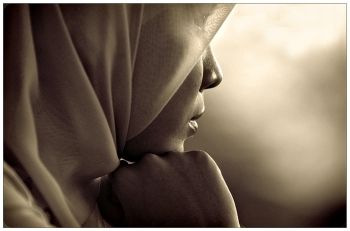
Publisher:
Bonnie King
CONTACT:
Newsroom@Salem-news.com
Advertising:
Adsales@Salem-news.com

~Truth~
~Justice~
~Peace~
TJP
Mar-12-2009 07:39

 TweetFollow @OregonNews
TweetFollow @OregonNews
Hijab in America
Salem-News.comHijab represents religious freedom in America in contrast to other parts of the world.
 Courtesy: alqamardesigns.files.wordpress.com |
(BOSTON, Mass.) - Hijab in America is a frequently controversial topic. The wearers are subjected to legal complications and verbal or violent attacks. However it is also a way for women to identify and express themselves, and is a form of liberation for the wearers.
Maria Hussain expresses this sentiment in her article entitled “Wearing Hijab in America. ”
“This is an example of how we can go about quietly struggling against evil. And, hijab is precisely one of the symbols of this struggle. It is a sign that says, "I believe in Allah and I believe in forbidding what is evil and encouraging what is good." It is an outward acknowledgement of an inner faith for which we are willing to sacrifice our egos and work hard for, in order to bring about positive social change."
The U.S government, media, and even Western feminist organizations often portray hijab as an oppression of women—but this is not the case. Samuel Cole explains the way that hijab liberates in his article “Donning the Hijab. ”
"In part because of this apparent restriction from the public realm, many Americans see the Muslim hijab as a symbol of female oppression. Despite this perception, Islam is growing rapidly in America—and female converts outnumber males four to one."
Indeed, according to my sister the hijab is not a symbol of oppression, but is instead a symbol of liberation. Naheed Mustafe, a Canadian woman who converted to Islam, writes that "young Muslim women are reclaiming the hijab... to give back to women the ultimate control over their bodies."
Yet to most Americans this is a strange assertion. How can a law that restricts a woman's dress be liberating? To Muslims the answer is easy. The Islamic tradition of hijab frees women from being perceived primarily as sexual objects."
Unfortunately the legal disputes and violence concerning hijab in America disrupt the process of liberation and expression and can turn hijab into something negative.
Fairly recently a woman was gunned down outside her home in Fremont California. She was 37-years old and had six children. Her brother suggested that hijab is the reason she was targeted.
This type of situation illustrates that animosity towards “terrorism” can lead to violence directed at symbols and ideology. It creates a conflict for hijab wearers in America because the fear of violence can cause people to hide their culture and religion. Faced with this type of deadly violence, a woman may have to decide between religious expression that can contribute to orientalism, and assimilation into mainstream culture.
One other demonstrative case is that of a Palestinian American Muslim named Carol. When attempting to get passports at a US Consulate in Jerusalem, her pictures were repeatedly denied, even when she met the requirement of “showing the face to the hairline and ears” while wearing hijab. Though these policies are reportedly stricter than those in the actual US, it is still distressing that the US has a hand in enforcing laws that violate religious freedom.
Fortunately there are also positive legal decisions happening in the United States. In Oklahoma in 2004 the school district attempted to restrict a 12-year old student from wearing hijab. The U.S. Justice department backed her side in the legal battle.
In Alabama the driver’s liscence photo rule was changed to allow hijab. If one observes the global situation concerning hijab it becomes clear that America is one of the better places to be an American Muslim woman; however the issue is more complicated.
 Hijab in Iran |      googlec507860f6901db00.html | |
Contact: adsales@salem-news.com | Copyright © 2025 Salem-News.com | news tips & press releases: newsroom@salem-news.com.
Terms of Service | Privacy Policy | ||

All comments and messages are approved by people and self promotional links or unacceptable comments are denied.
Ali October 7, 2009 1:02 am (Pacific time)
hijab my choice no one force me. http://myislam.zoomshare.com/
[Return to Top]©2025 Salem-News.com. All opinions expressed in this article are those of the author and do not necessarily reflect those of Salem-News.com.